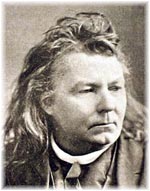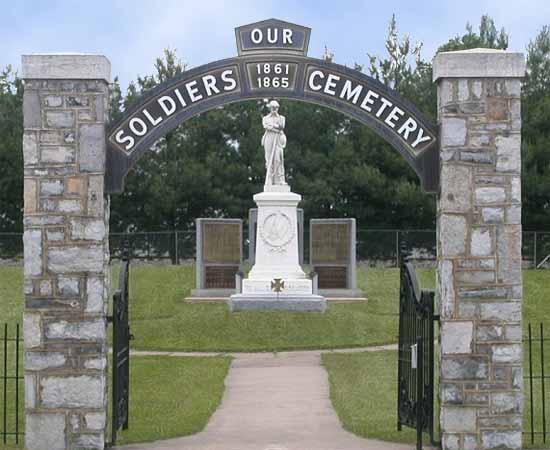Shenandoah County and the Civil War
".... my view is substantially Lee's. As an American constitutional problem, that question remains unsolved: solution by arms is hardly testimony to the rule of law."
"Lee's tragedy, and ours as Americans, was that he held firmly and correctly to Duty, Honor, Country - when "Country", thru a failure of the framers of our Constitution, had not been defined."
--Bill Thayer's preface to Douglas Southall Freeman: R. E. Lee
From the opening battle at Manassas to its end at Appomattox, no state was as fought over in the Civil War as Virginia. Perceived as a strategic key, the lower Shenandoah Valley became a continual battleground. No other part of the country saw as much fighting.

Though there were a number of larger set-piece battles, almost every inch of the northern Valley was fought over not once, but many times. Winchester changed hands 72 times; and Columbia Furnace here in Shenandoah County wasn't just torched, it was destroyed three different times.
The early part of the War was dominated by 'Stonewall' Jackson's campaigns. Until his death at Chancellorsville, this professor turned general used the Shenandoah's valleys and mountains to leverage tiny forces against overwhelming odds. Jackson's defeat of four armies in less than two months is regarded as genius by tacticians worldwide. From the 'Desert Fox' Rommel to 'Stormin Norman' Schwarzkopf; the Valley Campaign is still studied by military students.
As the War ground on, military action against tenacious Southern armies turned into ideological fervor against its people. Frustrated by his inability to defeat forces in the Shenandoah, Sheridan was instructed to destroy the Valley:"It is desirable that nothing should be left to invite the enemy to return. ....Do all the damage to railroads and crops you can. Carry off stock of all descriptions, and negroes, so as to prevent further planting. If the war is to last another year, we want the Shenandoah Valley to remain a barren waste."
In an orgy of destruction called "The Burning", the Shenandoah was so completely sacked and devastated that Sheridan boasted '... a crow flying over must carry it's own provisions.' Grant's written orders exempted homes, but restraint failed in the reality of destruction. Sheridan set a new standard of brutality which only escalated, providing justification for later policies of obliteration.

A Federal officer wrote: "We are burning and destroying everything in this valley, such as wheat stacks, hay stacks, barns, houses. Indeed, there will be nothing but heaps of ashes and ruins..." Another trooper wrote home: "We burnt some sixty houses and all most of the barns, hay, grain and corn .... It was a hard-looking sight to see the women and children turned out of doors at this season of the year."
"The atmosphere, from horizon to horizon, has been black with the smoke of a hundred conflagrations, and at night a gleam brighter and more lurid than sunset has shot from every verge.... The completeness of the devastation is awful. Hundreds of nearly starving people are going north.... not half the inhabitants of the Valley can subsist on it in its present condition."At the end of the American Revolution, Virginia-influenced leaders of the nation recognized the importance of reconciliation, and prohibited sanctions against former Crown supporters to reunify our fledgling nation. At the end of the Civil War no such sentiment existed. The judgement was for punishment, retribution, and subjugation; President Johnson was almost impeached for promoting reunion.

The resulting era of Reconstruction abolished existing Southern governments(1), disenfranchised ex-Confederate military and civil authorities, divided the South into military districts, had the army register voters and run elections, instituted martial law, set guidelines for rejoining the union, and ensured that black and white Republicans would rule.
Physical devastation was completed by economic and political destruction. The only proposal the Radicals failed to impose on the former Confederate states was total land re-distribution and mass executions.
It wasn't until after WWII that the Southern economy began to catch up to the rest of the country. From industrialization 50 years delayed, black civil rights and urban ghetto poverty(2), to military bases still on the vestiges of the occupation districts, or the unresolved legal issues -- the Civil War was a disaster for America.
We are Americans. No matter what your view of the Civil War, all of us who live in the Shenandoah live with its lingering effects. We walk this ground, of which dead men and women we have loved are part, as they are part of us. Pace requiem.

"Any society which suppresses the heritage of its conquered minorities, prevents their history, and denies them their symbols, has sewn the seed of its own destruction." -- William Wallace
Footnotes:
- All except President Johnson's home-state, Tennessee, already under Federal control.[back]
- The standard myth of Southern resistance to black voting rights via the Black Codes, or 'Jim Crow laws', rings hollow in light of the fact that the laws were all started under Federal occupation and Radical control. It's true the Southern establishment didn't want black equality; it's equally true the Northern-controlled interim governments didn't want it either. True black voting franchise lasted until Republicans gained full control; then the black vote was no longer needed and discarded. [back]
- Sheridan's policy inspired Sherman to write "Extermination, not of soldiers alone, that is the least part of the trouble, but the [Southern] people." In turn, both set the stage for the genocide against the western Indian nations. It was Sherman , not Hitler, who first used the chilling phrase "the final solution" to the Indian problem as a euphemism for extermination (letter to Grant). Sheridan applied his experience of Shenandoah food depravation to the destruction of the buffalo herds.[back]
1861-65
'Civil War in the Shenandoah Valley' is the best resource
Virginia Places is thorough and the commentary insightful.
Confederate Monuments and commentary on their place in Southern society
National Parks' Civil War in the Shenandoah Valley
Related Links:
Linkfest of Valley Campaign books, via Amazon
PBS series on the post-War west